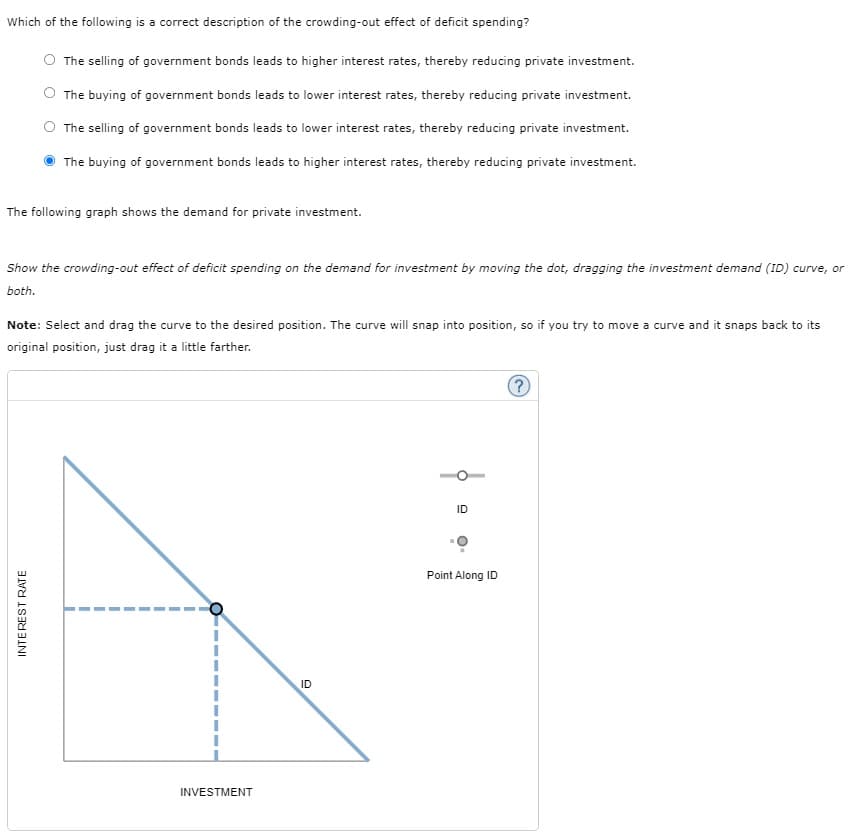Which of the following is a correct description of the crowding-out effect of deficit spending? The selling of government bonds leads to higher interest rates, thereby reducing private investment. The buying of government bonds leads to lower interest rates, thereby reducing private investment. The selling of government bonds leads to lower interest rates, thereby reducing private investment. The buying of government bonds leads to higher interest rates, thereby reducing private investment. The following graph shows the demand for private investment. Show the crowding-out effect of deficit spending on the demand for investment by moving the dot, dragging the investment demand (ID) Soth. Note: Select and drag the curve to the desired position. The curve will snap into position, so if you try to move a curve and it snaps back t original position, just drag it a little farther. INTEREST RATE INVESTMENT ID ID Point Along ID
Which of the following is a correct description of the crowding-out effect of deficit spending? The selling of government bonds leads to higher interest rates, thereby reducing private investment. The buying of government bonds leads to lower interest rates, thereby reducing private investment. The selling of government bonds leads to lower interest rates, thereby reducing private investment. The buying of government bonds leads to higher interest rates, thereby reducing private investment. The following graph shows the demand for private investment. Show the crowding-out effect of deficit spending on the demand for investment by moving the dot, dragging the investment demand (ID) Soth. Note: Select and drag the curve to the desired position. The curve will snap into position, so if you try to move a curve and it snaps back t original position, just drag it a little farther. INTEREST RATE INVESTMENT ID ID Point Along ID
Chapter13: Federal Deficits, Surpluses, And The National Debt
Section: Chapter Questions
Problem 13SQ
Related questions
Question
pls check the first question and do the graph. very confused with the graph part

Transcribed Image Text:Which of the following is a correct description of the crowding-out effect of deficit spending?
The selling of government bonds leads to higher interest rates, thereby reducing private investment.
The buying of government bonds leads to lower interest rates, thereby reducing private investment.
The selling of government bonds leads to lower interest rates, thereby reducing private investment.
The buying of government bonds leads to higher interest rates, thereby reducing private investment.
The following graph shows the demand for private investment.
Show the crowding-out effect of deficit spending on the demand for investment by moving the dot, dragging the investment demand (ID) curve, or
both.
Note: Select and drag the curve to the desired position. The curve will snap into position, so if you try to move a curve and it snaps back to its
original position, just drag it a little farther.
INTEREST RATE
INVESTMENT
ID
ID
Point Along ID
?
Expert Solution
This question has been solved!
Explore an expertly crafted, step-by-step solution for a thorough understanding of key concepts.
This is a popular solution!
Trending now
This is a popular solution!
Step by step
Solved in 2 steps with 1 images

Knowledge Booster
Learn more about
Need a deep-dive on the concept behind this application? Look no further. Learn more about this topic, economics and related others by exploring similar questions and additional content below.Recommended textbooks for you







Economics (MindTap Course List)
Economics
ISBN:
9781337617383
Author:
Roger A. Arnold
Publisher:
Cengage Learning
